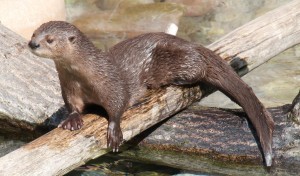
Spotted-necked Otter, Lutra maculicollis, can be recognized by the brown and white spotting on the throat and underside. They are smaller than sea otters and have slim bodies and long, tapering tails. Toes are strongly webbed. The chocolate to reddish brown fur in this otter is thick and this serves to keep them dry and warm in the water as there is no layer of body fat. This animal may be about 1 meter long and averagely weigh 3kg.
Spotted-necked otters favors unsilted, unpolluted water in which fish, crabs, and frogs occur, unfortunately, its freshwater habitat gets polluted and generally degraded in agriculture associated activities. Nigerian otters are threatened in the south by deforestation and water pollution caused by overpopulation and oil industry activity.
The spotted-necked otter is mostly diurnal with peaks of activity during early morning and late afternoon. It is very agile and at home in water but spend most of its time on land. Fish, crabs, frogs and insects are eaten. They do not hunt cooperatively but live in groups of about five individuals, which may be all male, or a female with her offspring. Gestation period of 2 months results in the production of a litter of 1 to 3 pups, which stays with the mother for the first year.





















